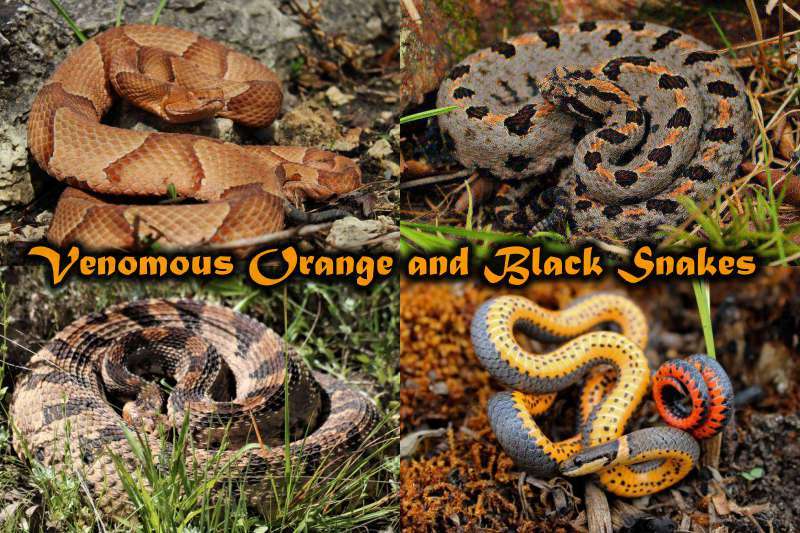Nature has a diversity of all kinds. It shows very prominently in the various types of snakes there are in this world. Some are beautiful, some are venomous, and some are beautiful and venomous. Today, we’ll be talking about venomous orange and black snakes that are as stunning as they are poisonous.
Here’s our list of 15+ venomous orange and black snakes.
List of Venomous Orange and Black Snakes
1) Pygmy Rattlesnake

First on this list of venomous orange and black snakes is the Pygmy Rattlesnake. These rattlesnakes are considerably small in size and belong to the viper family. Its skin color differs with subspecies, ranging from brown to gray. A stripe of orange runs along its body, paired with several dark splotches.
Pygmy rattlesnakes produce very small amounts of venom. Their venom contains cytotoxins that cause hemorrhage and tissue toxicity, though the venom lacks any neurotoxins. The bite of this snake is certainly dangerous but not lethal for humans.
- Common Name: Ground Rattlesnake, Hog-Nosed Rattlesnake, Little Rattlesnake, North American Smaller Rattlesnake, Oak-Leaf Rattler, Pygmy Ground Rattlesnake, Small Rattlesnake, Southeastern Ground Rattlesnake, Southern Ground Rattlesnake, Southern Pygmy Rattlesnake, Spotted Rattler, Spotted Rattlesnake, Southern Rattlesnake
- Scientific name: Sistrurus miliarius
- Size: 40 – 60 centimeters (16 – 24 inches)
- Location: Southeastern United States
2) Russell’s Viper
Russell’s Viper is a dangerously venomous snake species and one of the “big four,” i.e., the four deadliest snake species in India. Its venom causes severe pain, and kidney failure, among many other symptoms and can even lead to death. Russell’s Viper’s venom is also known to induce thrombosis and is used for medical purposes.
This snake is fairly large and thick. Its body is orange-brown and covered with strings of orange ellipses bordered with black. The color of the ventral side is cream and lacks any spots.
- Scientific name: Daboia russelii
- Size: 124 centimeters (49 inches)
- Location: Coromandel Coast of India
3) Kimberley Death Adder

Kimberley Death Adder is a fairly newly discovered species. The snakes of this species have a thick, stocky body, which is broader in the middle and narrower in the extremities.
The dorsal side of its skin is orange-brown, spotted with dark brown cross bands with darker margins. The ventral side is a pale orange.
Kimberley Death Adder is venomous. It is also declared a Vulnerable species by IUCN.
- Scientific name: Acanthophis cryptamydros
- Size: 64.5 centimeters (25.5 inches)
- Location: Wotjulum to Kununurra in northwestern Australia
4) Saw-Scaled Viper
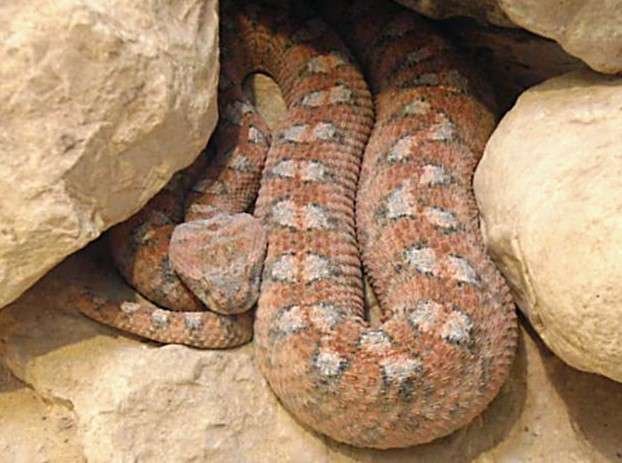
Saw-Scaled Viper is another one of the “big four” of India. In fact, it is the smallest among the four. The background of its skin is a pale reddish color, with orange-brown elliptical patterns running all over the body. The patterns are bordered by dark brown. The front of the snake is cream and dotted with brown splotches.
Saw-scaled viper is also highly venomous, and its venom is very potent. It can lead to death and causes several painful symptoms, including hemorrhage, melena, hemoptysis, and acute kidney injury.
- Common Name: Indian saw-scaled viper, little Indian viper
- Scientific name: Echis carinatus
- Size: 38 – 80 centimeters (15 – 31 inches)
- Location: India, Sri Lanka, Bangladesh and Pakistan in Indian Subcontinent, Oman, Masirah (Island), eastern United Arab Emirates, Iraq and southwestern Iran in Middle East, Afghanistan, Uzbekistan, Turkmenistan and Tajikistan in Central Asia
5) Harlequin Coral Snake
Harlequin Coral Snake has an interesting color palette for its skin. The snake has multiple colored rings of different sizes along its body. It starts with a black head, followed by a thick orange or red ring, and then a narrower black ring, and so on. Each black and red ring is divided by a thin yellow ring.
This snake species is extremely venomous. While death by them is rare, their venom-containing neurotoxins harm the body in other dangerous ways. For example, rapid paralysis and respiratory failure.
- Common Name: Eastern Coral Snake, Common Coral Snake, American Cobra, Oral Adder, Elaps Harlequin Snake, Florida coral snake, North American Coral Snake, Red Bead Snake, Thunder And Lightning Snake
- Scientific name: Micrurus fulvius
- Size: 80 – 122 centimeters (31 – 48 inches)
- Location: Southeastern United States
6) Northern Brown Snake
The Northern Brown Snake is a highly venomous species of snake. The venom contains several neurotoxins, nephrotoxins, and a procoagulant. It’s a deadly venom that is injected fast and painlessly, thanks to the small fangs of the snake. It causes several dangerous effects on humans and other animals.
Northern brown snake’s coloring differs based on their location. A particular color scheme of this snake is orange-brown with or without patterns on the back. The front side of it is a pale orange or cream with pink splotches.
Common Name: Gwardar
Scientific name: Pseudonaja nuchalis
Size: 177 centimeters (5 feet 10 inches)
Location: Australia
7) Florida Cottonmouth Snake
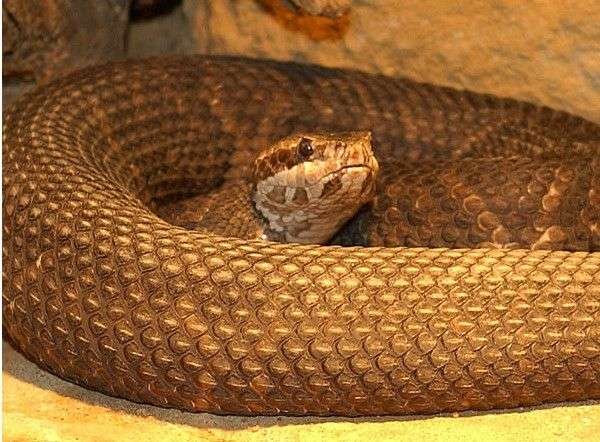
The next on the list of venomous orange and black snakes list is the Florida Cottonmouth. This large snake has a pale orange body with thick brown parallel stripes. Those brown stripes are dotted with some dark spots.
Florida cottonmouth is a highly venomous snake. Its venom is very potent and has hemolytic effects. After being injected, it causes extensive neurosis and can even cause death. This snake species has a mortality rate of 17%.
- Scientific name: Agkistrodon conanti
- Size: 189 centimeters (74.4 inches)
- Location: Southern Georgia and the Florida Peninsula in the United States
8) Yellow-Bellied Sea Snake
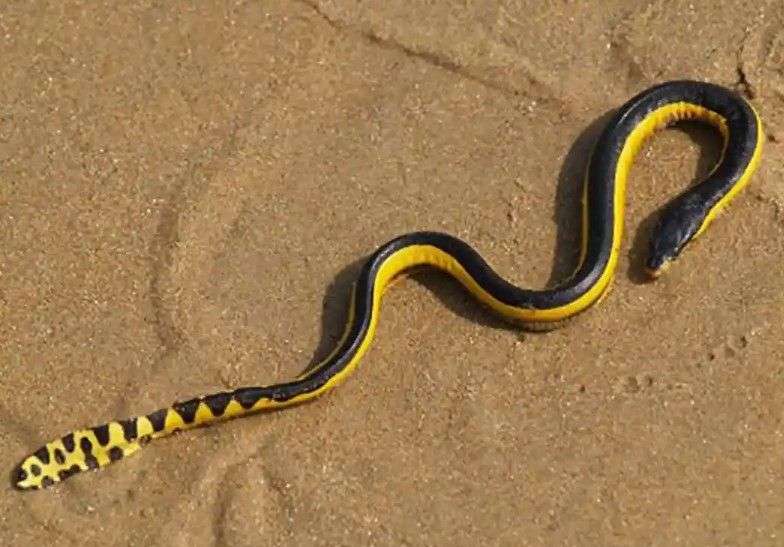
Yellow-Bellied Sea Snake, as the name implies, is a species of sea snake with a distinct yellow belly side. But in some cases, the color of the ventral side skin is orange rather than bright yellow. A single, thick, black stripe runs along the middle of the body and ends with discontinuous patterns at the tail.
Yellow-bellied sea snakes are very venomous. The potent venom contains multiple different neurotoxins and two different isotoxins. It can affect skeletal muscles and cause muscle injury, neuromuscular paralysis, and kidney damage.
- Scientific name: Hydrophis platurus
- Size: males- 72 centimeters (28 inches), females- 88 centimeters (35 inches)
- Location: Tropical Indian and Pacific Ocean, Costa Rica, southern California, northern Peru, Australia, New Zealand, Russia, Tasmania
9) Western Terrestrial Garter Snake
Western Terrestrial Garter Snake is a mildly venomous snake species native to western North America. After being injected into a rat, the venom killed its muscles. In humans, the venom of the snake causes swelling with trapped body fluid.
Western terrestrial garter snakes have an orange body with two white stripes at the sides. Black dots pattern the orange areas of the skin. In some cases, the orange is darkened to be a shade of brown.
- Scientific name: Thamnophis elegans
- Size: 46 – 104 centimeters (18 – 41 inches)
- Location: central British Columbia, central Alberta, and southwestern Manitoba in Canada, western Nebraska and the Oklahoma Panhandle in the USA, Baja California, Mexico
10) Pine Woods Littersnake
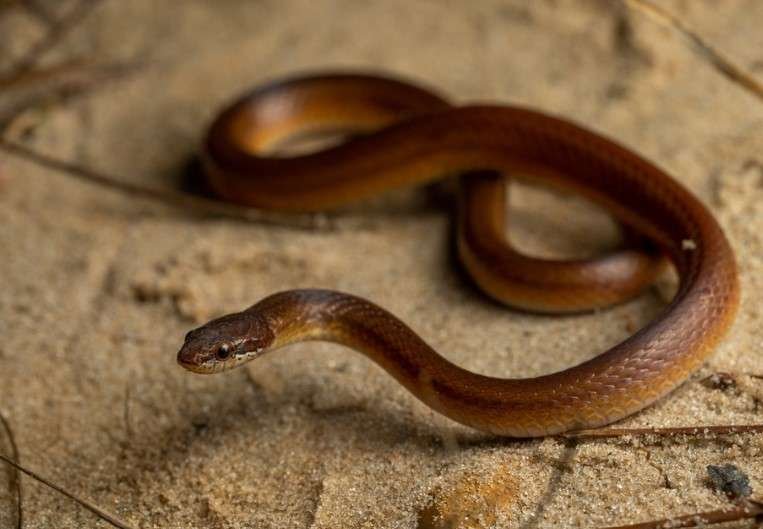
The name Pine Woods Littersnake comes from its natural habitat in the pine and mixed pine forests. The snake is small and has an orange-skinned body. In some snakes, the color differs to brown or reddish-orange or deep yellow.
Pine Woods Littersnake is a mildly venomous species. Their venom doesn’t affect humans dangerously. They are frequently predated by fellow snakes, the Kingsnake and the Southern Black Racer.
- Common Name: Pine Woods Snake, Yellow-Lipped Snake, Brown-Headed Snake
- Scientific name: Rhadinaea flavilata
- Size: 25 – 33 centimeters (10 – 13 inches)
- Location: Coastal North Carolina and South Carolina, Peninsular Florida, Georgia, Alabama, Louisiana
11) Eastern Copperhead Snake

Eastern Copperhead Snake is coming up next for this venomous orange and black snakes list. These North American natives are thick and have orange-brown skin. The skin is covered with brown uneven stripes, which are bordered with a darker brown.
Eastern copperhead snakes have mild venom that isn’t lethal to humans. They are prone to bite as a warning when threatened or stepped on and add very small to no amount of venom in the bite. CroFab antivenom is injected to treat their victims.
- Common Name: Copperhead Snake
- Scientific name: Agkistrodon contortrix
- Size: 50 – 95 centimeters (20 – 37 inches)
- Location: Eastern North America
12) Ring-Necked Snake

Ring-Necked Snakes are a beautiful species of snakes with an enchanting color scheme. The back of their body is gray, and the belly side of it is a vibrant orange. The most distinct aspect of their appearance is the orange ring around their neck, thus the name of the species.
Ring-necked snakes are mainly a nonvenomous species. But there are theories of them being venomous due to the high level of phospholipase activity in their Duvernoy’s gland secretions.
High phospholipase activity can indicate it is venom. Also, the feeding patterns of these snakes are consistent with venomous ones.
- Common Name: Ringneck Snake
- Scientific name: Diadophis punctatus
- Size: 25 – 38 centimeters (10 – 15 inches)
- Location: Central Mexico, southeastern Canada, United States
13) Western Ground Snake
Western Ground Snake is a small snake that is found widespread all over the southeastern side of America and northern Mexico. The snakes of this species are nocturnal and prey mostly on insects.
Its coloration varies based on its location. A more popularly seen color of this snake is orange with black stripes.
Western ground snake is considered to be a nonvenomous species. But the shallow grooves on the outer side of the rear teeth indicate that it might be able to produce venom. But the venom is very mild and hardly has any effects on humans.
- Common Name: Variable Ground Snake, Common Ground Snake, Miter Snake
- Scientific name: Sonora semiannulata
- Size: 20 – 48 centimeters (8 – 19 inches)
- Location: Southwestern United States, northern Mexico
14) Western Ribbon Snake
Western Ribbon Snake has plenty of colors to show off. Its back is striped with strings of black, yellow, and orange-yellow. These “ribbons” of colors led to the name of the species. The ventral part of its skin is a pale cream.
Like our previous two entries, the Western ribbon snake has also been declared as nonvenomous. But according to reports, its saliva has toxic properties, though mild enough not to harm humans. It is also a shy creature and will not bite until provoked.
- Scientific name: Thamnophis proximus
- Size: 43 – 127 centimeters (17 – 50 inches)
- Location: Western United States, Mexico, and Central America
15) Common Garter Snake
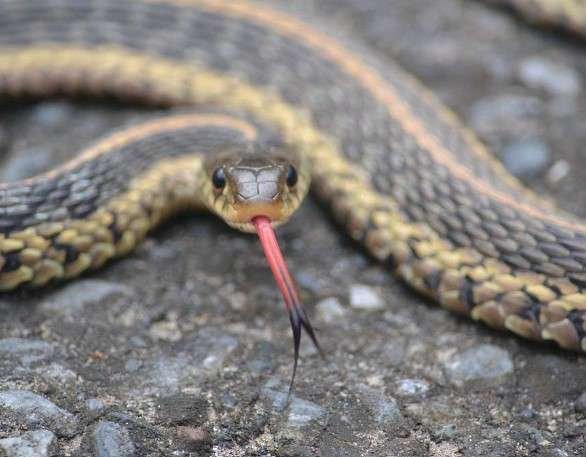
Common Garter Snake is a species of snake native to the North American continent. It is the state reptile of Massachusetts. The snake has beige, black, and orange in its color scheme.
The dorsal side of the body is striped with black and beige, partnered with orange filling the rounded edges of the black stripes. The ventral side is completely beige.
Common garter snakes are venomous, and their saliva is toxic. But the venom in their saliva is very mild and only dangerously affects amphibians and small animals. Their bite is not harmful to humans and only causes slight burning or swelling.
- Scientific name: Thamnophis sirtalis
- Size: 55 – 137 centimeters (22 – 54 inches)
- Location: North America
16) Timber Rattlesnake
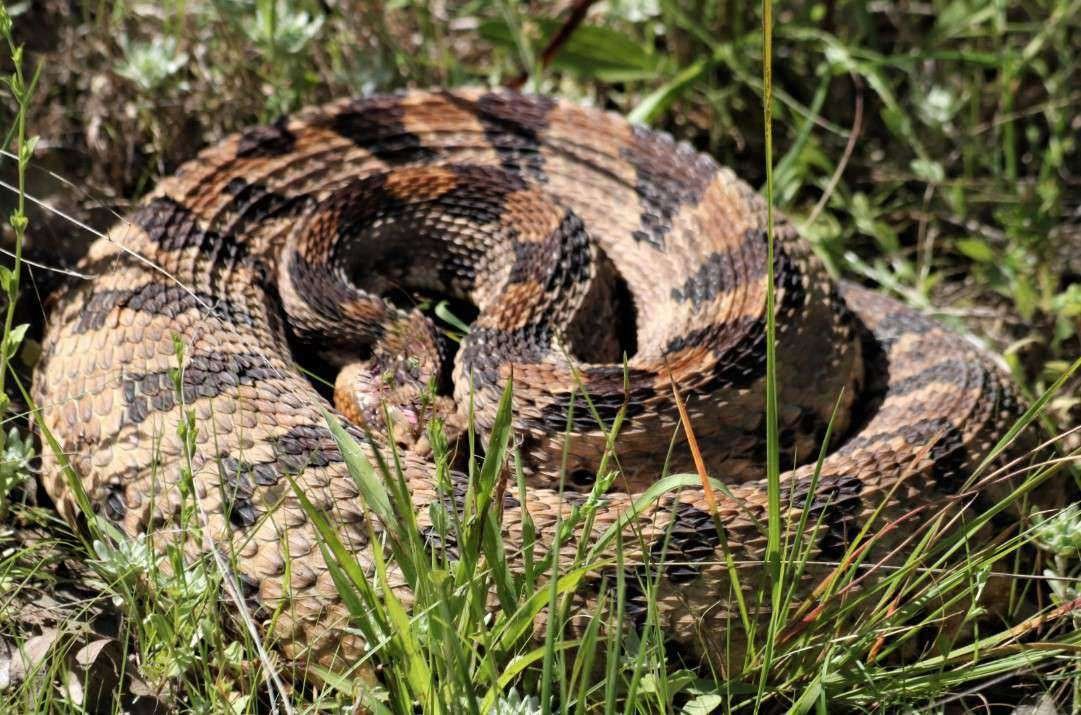
The last entry on our list of venomous orange and black snakes is the Timber Rattlesnake. A member of the viper family, this species of rattlesnakes is very poisonous and considered one of the most dangerous snakes in North America.
There are four venom patterns in this species. The venom is neurotoxic, hemorrhagic, and proteolytic.
The skin of timber rattlesnake is a yellowish gray with black patterns and an orange stripe running horizontally along the body. The tail is black with thick brown stripes and rattles.
- Common Name: Canebrake Rattlesnake, Banded Rattlesnake
- Scientific name: Crotalus horridus
- Size: 91 – 152 centimeters (36 – 60 inches)
- Location: Northeastern United States
With this, we conclude our list of 15+ venomous orange and black snakes. Let us know your thoughts regarding this. And if you liked this piece, don’t forget to check out our similar articles.
Also Read:
Anamika has a fascination with all living things. Being a Zoology student, she loves to know new interesting things about animals. She’s also a very keen fan of manga and anime. Writing is her passion, and writing about her favorite things is her boost of serotonin.
